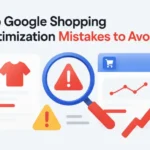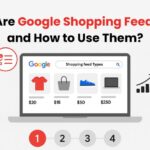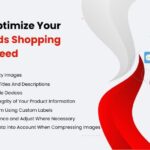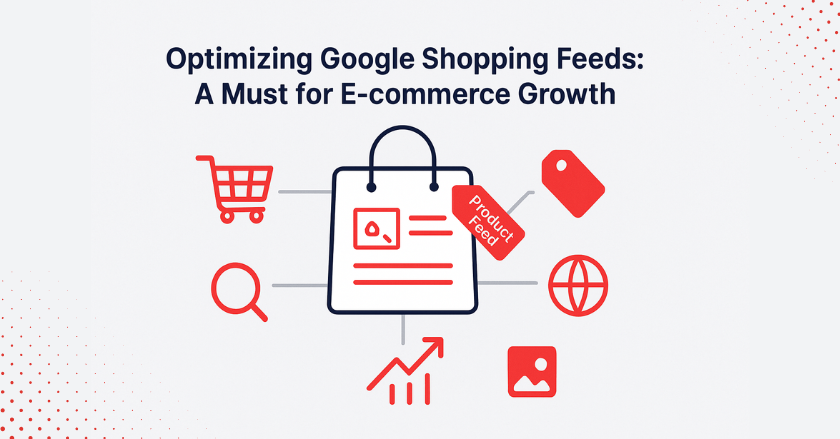
Google Shopping Feeds are lists of products with details about each one. They collect product information from a website and organize it into a simple format. You need to update your shopping feeds often to do well in a competitive market. Regular updates make sure customers see the correct details about your products. This includes up-to-date prices, stock availability, and any new features. When the information is fresh and accurate, it builds trust with customers and makes shopping easier for them.
Not updating your shopping feed can lead to wrong and outdated data. Imagine a shopper clicking on a product only to discover it is unavailable or has a different price. These problems can be frustrating and damage the reputation of your brand. These issues can be avoided by keeping the feed current. Customers and your company’s reputation both gain from it.
This guide explains how shopping feed optimization can boost your visibility on Google Shopping. Our goal is to ensure that your items stand out in this competitive market rather than just appearing. By employing effective tactics, we assist you in achieving success and visibility where it counts most.
What are Google Shopping Feeds?
A Google Shopping feed is very important for e-commerce stores. It helps organize product details simply and clearly. This includes product name, description, price, and pictures. You can create these files using Spreadsheets, XML, and TXT formats.
The main purpose of these feeds is to display detailed product listings. This makes it easier for buyers to find your items when they search. High-quality pictures and accurate product details make your products stand out and attract more attention.
Why is a Google Shopping Product Feed Important?
1. Better Search Results
It helps your items show in relevant search results.
2. Reach More People
It captivates more potential buyers.
3. Boost Sales
It increases sales by showing your products clearly and effectively.
A well-organized Google product feed can greatly improve click-through rates. It is a valuable tool for online stores to manage product details and catalogs.
Why is Optimization of Google Shopping Feeds Essential for Your E-commerce Success?
Optimizing your feeds is necessary for your business growth. Your shopping feed needs to be improved, just like the product pages on your website.
- When your feed is well-organized, it gives better information to Google. This makes your ads more likely to appear often because they match what customers are searching for.
- A good shopping feed is the foundation of your online marketing. It supports all your strategies and helps you stay ahead of the competition.
- If you ignore the quality of your Google Product feed, it can hurt your business. Competitors who improve their feeds will have an advantage over you.
By spending time and effort to make your feed better, you can stand out in the market. A well-made feed connects your products to the right customers. This ensures that people looking for your items can easily find them.
Best Practices for Google Shopping Product Feed Optimization
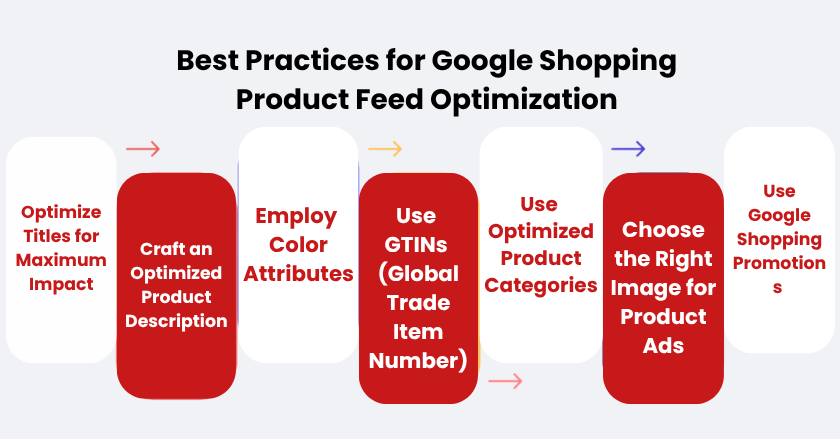
1. Optimizing Titles for Maximum Impact
Product titles play a vital role in determining the success of your Google listings. Google uses product titles to match your items with the right searches. If your titles don’t have the right keywords, your products might not appear in relevant results. This means you could miss chances to attract buyers.
- To improve your product’s visibility, focus on using keywords your target audience frequently searches for. Optimized titles ensure your listings reach the right people, boosting click-through rates and conversions.
- Missing out on key keywords can reduce your product’s reach and limit your business potential. Product titles aren’t just about pleasing Google’s algorithm.
- They’re also important for buyers. A clear and well-written title helps customers quickly determine if your product meets their needs. Include essential keywords to ensure your product appears in relevant searches.
Avoid using complex words or technical terms that might confuse your audience. Instead, use simple and clear language. Adding details like your product’s brand and material can further improve your title’s appeal. Familiar brands and specific materials help build trust, encouraging buyers to click through and explore more. By balancing keyword optimization with clarity, you can attract more shoppers, improve your product’s visibility, and increase conversions.
Tips for Writing Powerful Product Titles
- Be Descriptive and Clear
Ensure your titles describe the product in simple, straightforward terms.
- Use High-Value Keywords
Pay attention to keywords with low competition and a consistent search volume. This strategy helps you rank higher and establish authority faster.
- Avoid Promotional Words
Save promotional details for other product attributes. Keep titles strictly about the product.
- Include Key Features
Mention important details like model, size, type, or color. However, avoid overloading the title with too much information.
2. Crafting an Optimized Product Description
Writing a strong product description is crucial to showcase your product effectively. It provides significant data clearly and engagingly. An optimized description helps customers quickly understand your product’s features and value.
Significant Elements of a High-Quality Product Description
- Include Relevant Keywords
Use keywords that your potential customers frequently search for. This strategy improves your website’s search engine ranking. Your website will consequently rank higher and provide more leads and sales. - Highlight Unique Features
Focus on what sets your product apart. Describe the special features that set it apart from competitors. - Use Vivid and Descriptive Language
Choose words that help customers imagine using your product. Create a mental picture by describing the product in a detailed and engaging way. - Present Information in Bullet Points
Organize key details into concise bullet points. This format is easy to read, especially on mobile devices.
3. Employing Color Attributes
Use colors strategically to attract customers who know exactly what they want. If they have a specific color or product vision in mind, matching their expectations is key. Offering precise color options can help you stand out and boost customer satisfaction. In some countries, providing the correct color attribute for apparel and accessories is even a legal requirement.
- Previously, many sellers streamlined colors in Google Shopping feeds. They often replaced unique color names with more common, searchable terms. For instance, “Pomegranate” might have been labeled as “light red” or just “red.”
- Although it used to be widespread, this is no longer acceptable. Google now checks your landing page’s microdata to confirm product details. The color in your feed is marked as a mismatch if it differs from the landing page. To avoid this, stop using simplified colors and list the exact names instead.
Make sure to include both primary and secondary colors. You can specify one primary color and up to two secondary colors. Additionally, you can combine material with color. For items made of materials like gold, merge the material and color attributes. For example, use “gold ring” to clearly describe the product. This gives shoppers a deep understanding of what they’re buying.
4. Using GTINs (Global Trade Item Number)
It plays a key role in product optimization and is favored by Google. Products or items with GTINs are often prioritized in search rankings. A GTIN is a unique code assigned to each product. This code helps identify products easily and ensures no two items have the same identifier. While GTINs are no longer mandatory, investing in them can still be highly beneficial.
Why Are GTINs Important for Optimization?
GTINs offer several advantages that can boost your product’s success online
- Enhanced Product Visibility
GTINs make your items more visible to potential buyers. Search engines rely on these unique codes to match products with relevant keywords. This increases the likelihood of your items appearing in search results, improving exposure.
- Accurate Product Details
GTINs store critical product information. These codes simplify inventory management, help locate products faster, and ensure seamless customer delivery.
- Better Search Rankings
Google’s algorithm often prioritizes products with GTINs. Items without these identifiers may rank lower, reducing their chances of being noticed in search results.
- Increased Conversion Rates
Customers can find your products attractive if you use GTINs. Better search rankings and clear product information can lead to more clicks and higher sales.
5. Using Optimized Product Categories
Organizing products using categories is key to a well-structured feed. It groups products clearly, making it easier for shoppers to find them on Google. Precise categorization ensures your items show in relevant search results. This boosts visibility and aligns your listings with Google Shopping taxonomy. As a result, it increases your chances of reaching potential buyers.
How Can You Categorize the Products?
- Avoid Unnecessary Terms
Exclude synonyms, promotional language, or unrelated search terms. Keep the focus solely on product type categorization.
- Use Specific Product Types
Choose detailed product type values. Include the Google product category attribute [google_product_category]. Ensure it spans at least two to three levels of hierarchy.
- Create a Proper Category Structure
Begin with a broad category and narrow it down to a specific subcategory.
Tips for Optimizing Product Categories
- Use Data and Insights
Analyze past data, user behavior, and category trends. These insights will help you spot new e-commerce trends and fine-tune your strategy for better results.
- Understand Search Intent
Think about what shoppers are searching for and match categories to their behavior.
- Highlight Product Traits
Choose categories that reflect your product’s key features and characteristics.
6. Choosing the Right Image for Product Ads
When people come across your ad, their initial impression is of your product images. Because of this, selecting photos that look appealing and professional is important.
Tips for Optimizing Product Images
- Add Alt Text for Better SEO
Increase your product listing’s SEO by adding alt text. Alt text allows Google’s crawler to understand and index your product.
- Use High-Quality Images
Always upload images in high resolution. Clear and sharp visuals show your products accurately. They avoid misleading details and highlight the true quality.
- Maintain a Consistent Visual Style
Ensure that the appearance of all your product images is consistent. Consistent backgrounds, styles, and quality create a strong and cohesive brand image.
7. Using Google Shopping Promotions
Adding promotions to your Google Shopping ads, like special discounts, helps drive quicker purchasing decisions. These promotions highlight price cuts and delivery options directly within your ads. This provides shoppers with key details at a glance.
Key Points for Creating Promotions
- Ensure you have a Google Shopping Ads and Merchant Center account. These are essential to join the Promotions program.
- Fill out the promotions form to begin.
- Follow the participation criteria and policies carefully. These guidelines keep your promotions safe and reliable for customers.
- Be aware that promotions are only available in certain countries.
- Plan the timing for your promotions. Choose when and how often you want them displayed with your product listings.
8. Using Custom Labels in Google Shopping
Custom labels are a powerful tool to organize your product feed. They help you categorize products based on specific business objectives. Using custom labels, you can better target audiences, highlight high-value items, and optimize your marketing strategies.
How to Use Custom Labels Effectively
- Group products by season, sales trends, profit margins, or other key attributes.
- Create custom labels for promotions, such as clearance items or special discounts.
- Use them to build audience segments, run remarketing campaigns, and design personalized ads.
Conclusion
As a Shopify seller, optimizing your Google Shopping Feeds is crucial for your e-commerce success. It directly impacts the success of your shopping campaigns. Poorly optimized feeds can limit your campaign’s performance. Many sellers struggle with common challenges when managing their shopping feeds:
- Maintaining accurate and consistent data across feeds.
- Facing keyword bidding problems that hurt campaign results.
- Tackling complications when selling products internationally.
- Dealing with product disapprovals that cause delays and frustration.
- Navigating the complexities of shipping and tax configurations.
- Managing technical issues like metafield creation and product variations.
- Handling listing errors or using low-performing keywords.
These problems can seriously affect your Shopify store’s performance. However, feed management apps offer an effective solution. They simplify optimization and make the process smoother. One excellent option is considering our Wixpa Google Shopping Feed. It’s a powerful feed management app built for Shopify sellers. With it, you can streamline your feed management and optimize your Google Shopping campaigns with ease!


